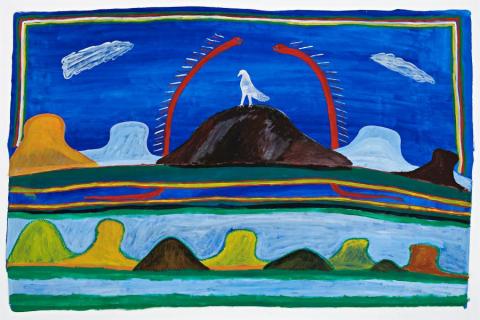GARIMALA, 1992
GINGER RILEY MUNDUWALAWALA
synthetic polymer paint on canvas
135.0 x 201.0 cm
Alcaston Gallery, Melbourne (cat. AK1439)
Private collection, Melbourne
Ginger Riley Munduwalawala grew up in the coastal saltwater homeland of the Mara people. He came from Ngukurr, formerly known as the Roper River Mission, in Ngalakan country. Riley's iconography perpetually returns to the narrative of his mother's country, and the spirits that inhabit it. This landscape includes the riverine lands adjacent to the Limmen Bight River.
Certain motifs seem to recur uniformly in Riley's paintings. Central to his compositions are the Four Archers. Large pyramid-like formations which emerge dramatically from an otherwise flat surrounding plain, the Four Archers are geographical structures approximately 55 kilometres inland from the Gulf of Carpentaria. Riley describes them as 'the centre of the earth, where all things start and finish'. According to ancestral dreaming, the rocks were created by Garimala, a large taipan snake, sometimes understood to be two creatures rather than one. Garimala is seen here as two red snakes rising up to meet each other, hovering above the Four Archers.
Another recurring spirit seen in our painting is Ngak Ngak, a majestic sea eagle, standing powerfully in the centre of the composition, asserting his dominance. Riley consistently paints this striking white-breasted eagle in profile and facing to the left. 'He plays the role of a sentinel or guardian, protecting the country ... For Riley, depicting Ngak Ngak is an act of homage, a means of honouring this protective spirit.'
The artist's back-catalogue of work can be viewed as a sequence of variations upon the same events. But the repetition of Riley's iconography is not a restriction, nor a lack of innovation. Rather, the endurance of his singular narrative allows for a greater depth of exploration, a greater revelation. From his earliest work Riley was distinctive for his non-traditional aesthetic. He employed brazen colour, subjects painted at dramatically different scales, unusual spatial arrangements, and crooked edged images. Riley's colour choices were daring and unexpected " the sky could appear yellow or blood red, or the earth an enchanting pink. His technique and aesthetic were truly unique, and challenged Western ideas and expectations of Aboriginal painting.
Ginger Riley was a tremendously successful artist who received a plethora of awards throughout his lifetime, including the Telstra National Aboriginal and Torres Strait Islander Art Award in 1987, the John McCaughey Memorial Art Prize in 1993, the first National Aboriginal and Torres Strait Islander Heritage Commission Award in 1993, and an Australia Council Fellowship for 1997/98. He was also the first Aboriginal artist to be offered a major retrospective of his work at the National Gallery of Victoria in 1997.
LEAH CROSSMAN
